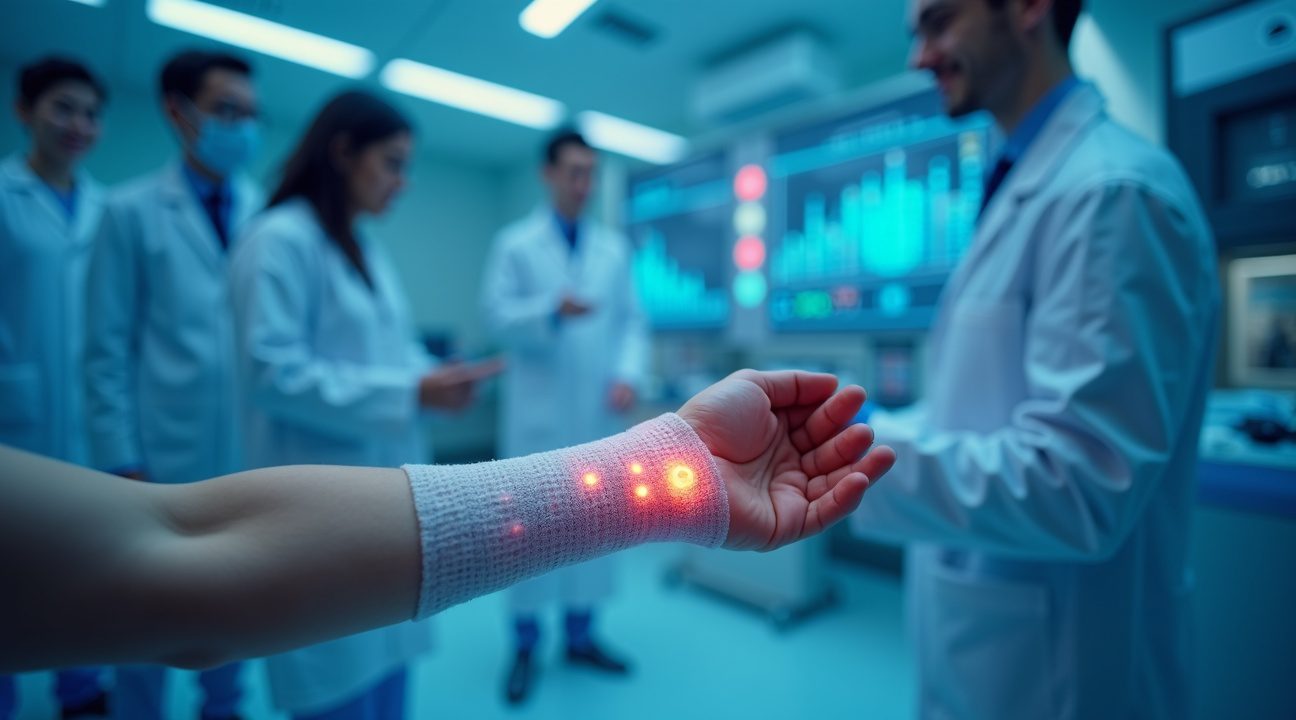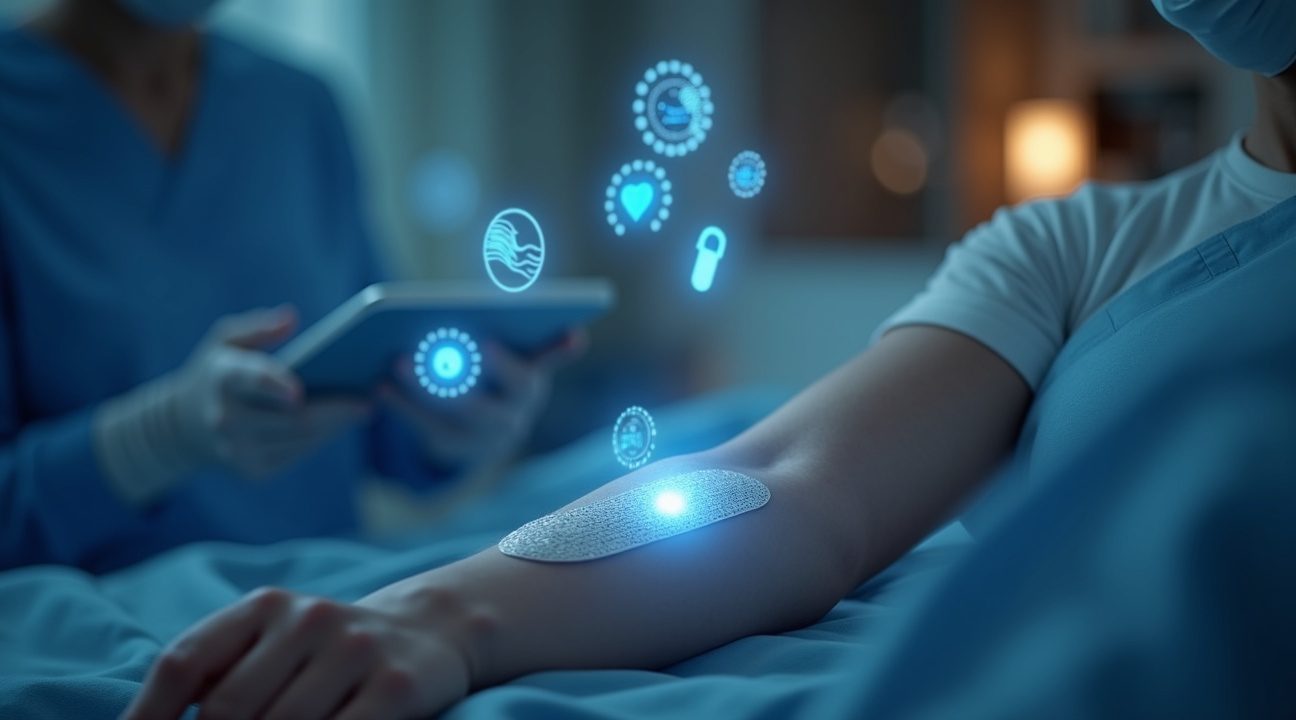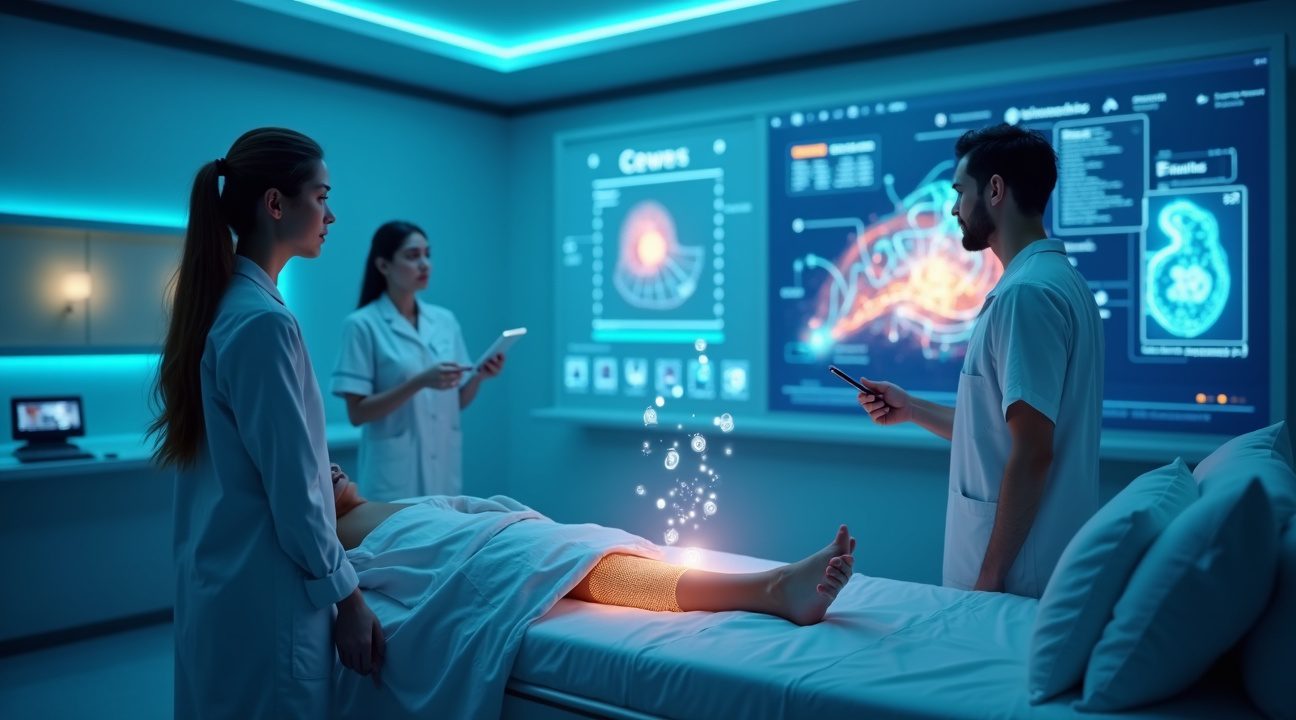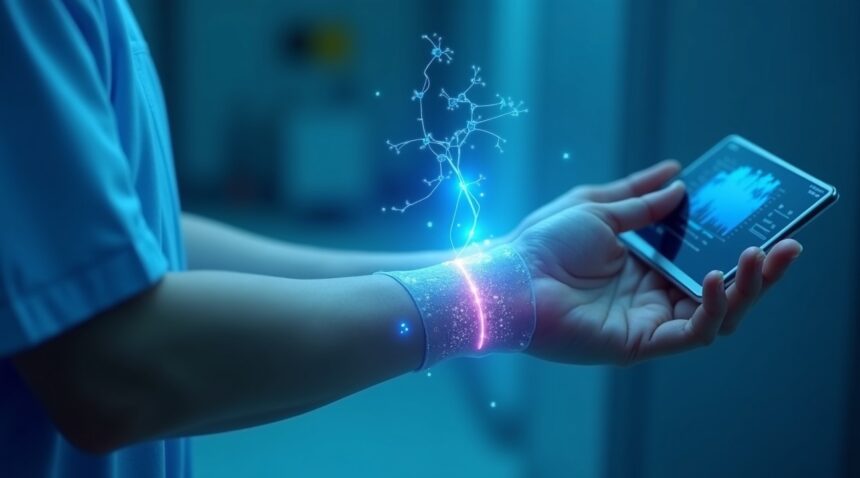Revolutionary smart bandages deliver controlled electrical pulses at approximately 200 millivolts per millimeter to accelerate wound healing up to three times faster than traditional treatments.
Clinical studies demonstrate that these bioelectronic devices achieve remarkable results, with treated wounds showing 82% closure rates by day seven compared to just 70.75% for conventional bandages. Integrating advanced monitoring systems, these smart bandages track healing progress in real-time, offering a transformative approach to modern wound care.
Key Takeaways
- Smart bandages use precisely controlled electrical stimulation to activate the body’s natural healing pathways, enhancing cellular migration and tissue regeneration at the molecular level.
- Clinical research shows healing rates up to three times faster than traditional treatments, with diabetic wounds healing 30% faster and some wounds achieving 98% prediction accuracy through AI monitoring.
- Advanced wireless biosensors continuously monitor wound metrics such as temperature, oxygen levels, heart rate, and inflammation markers, enabling remote healthcare management and personalized treatment adjustments.
- The technology incorporates water-activated power systems and biocompatible electrodes with standardized 1 cm spacing, making them practical for both clinical and home-care environments.
- These devices significantly benefit chronic wounds and burn injuries by creating hostile environments for bacteria while promoting proper collagen formation and reducing scarring.
Accelerated Recovery through Bioelectronic Innovation
Bioelectronic bandages represent a significant breakthrough in wound care technology. These sophisticated devices apply precise electrical stimulation directly to injured tissue, triggering accelerated cellular repair mechanisms that outperform conventional treatment methods by substantial margins.
Research teams have documented healing improvements of 200-300% compared to standard bandages. The electrical pulses stimulate fibroblast activity, increase blood flow, and promote faster epithelialization of damaged skin. Diabetic patients, who traditionally face slower healing times, benefit from 30% faster recovery rates with these smart devices.
Incorporation of Smart Sensors
Advanced sensor arrays embedded within each bandage continuously collect critical health data. Temperature fluctuations indicate infection risk, while oxygen level measurements reveal tissue viability. Heart rate monitoring provides systemic health insights, and inflammation markers help clinicians adjust treatment protocols in real time.
Efficient Power and Design
Water-activated batteries power these devices over extended periods without the need for external charging. Biocompatible electrodes maintain consistent contact with the wound bed using a standardized 1-centimeter spacing pattern. This design ensures optimal electrical field distribution throughout the treatment area.
Artificial Intelligence and Predictive Healing
Utilizing machine learning, AI algorithms analyze sensor data to predict healing outcomes with remarkable accuracy. These models process thousands of data points daily, identifying patterns in healing trajectories to inform dynamic decision-making. Healthcare providers receive instant alerts when intervention becomes necessary.
Maximized Effectiveness for Chronic Conditions
Chronic wound patients experience dramatic improvements with bioelectronic bandages. Diabetic ulcers—often resistant to healing—close significantly faster under electrical stimulation. Burn victims also benefit from reduced scarring and improved skin elasticity. Surgical wounds heal with minimal complications and superior cosmetic outcomes.
Infection Control and Pathogen Resistance
Electric stimulation creates an environment hostile to bacterial growth, reducing infection rates by 40-60% compared to traditional wound dressings. Simultaneously, tissues continue regenerating under enhanced conditions, promoting beneficial cellular activity and proper collagen formation.
Economic and Healthcare Advantages
Cost-effectiveness analyses reveal long-term savings despite higher initial device expenses. Faster healing leads to shorter hospital stays, reduced medication use, and fewer follow-up appointments. Insurance providers are increasingly recognizing these advantages and expanding coverage for smart bandage technologies.
Remote Care and Accessibility
Home healthcare applications improve treatment access for patients unable to visit clinical settings regularly. The remote monitoring capabilities of smart bandages allow for distant supervision, helping healthcare professionals track progress without in-person visits. This also improves patient compliance by minimizing daily intervention requirements.
Looking Ahead: Next-Generation Developments
Continued advancements in manufacturing are reducing production costs while enhancing device reliability. Future iterations are expected to include additional sensors for pH levels, bacterial detection, and medication dispensing directly through the bandage.
Ongoing clinical trials are exploring innovative applications such as post-surgical care, athletic injury management, and pediatric wound treatment. As research advances, scientific publications continue to validate the success and versatility of smart bandages in various medical scenarios.
The Future of Wound Healing
Smart bandages are transforming wound care from reactive treatment to proactive healing management. These bioelectronic devices bring measurable improvements in healing speed, infection prevention, and patient outcomes, making them an essential innovation across diverse healthcare environments.
Revolutionary Technology Heals Wounds with Electric Pulses Up to Three Times Faster
I find it fascinating how these smart bandages deliver precisely controlled electric field therapy through integrated stainless steel or ionically conductive electrodes. These advanced devices apply approximately 200 millivolts per millimeter directly to the wound bed for several hours daily, creating an optimal healing environment that accelerates tissue regeneration.
Proven Results from Clinical Research
Animal studies have consistently demonstrated that wounds treated with electrical stimulation close significantly faster than traditional treatments. Several research projects cite healing rates up to three times faster, with some showing dramatic improvements in closure times across various wound types.
One particularly compelling large preclinical study examined 100 wounds in rats and revealed remarkable results:
- On Day 7, electric field-treated wounds achieved an average closure rate of 82% ± 2.1% compared to 70.75% ± 2.3% for control groups.
- By Day 14, the difference became even more pronounced — treated wounds shrank to just 0.01 ± 0.005 cm² while control wounds measured 0.24 ± 0.03 cm².
These smart bandages have also shown exceptional promise for specific medical conditions. Research indicates they can heal chronic wounds 30% faster in diabetic mouse models, addressing a critical healthcare challenge. Similarly, diabetic ulcers responded with 30% faster healing rates compared to untreated groups, offering hope for millions of patients struggling with slow-healing wounds.
The bioelectronic medicine approach represents a significant advancement in wound care technology. Unlike traditional bandages that simply protect wounds, these intelligent devices actively participate in the healing process. The controlled electrical stimulation promotes cellular activity, enhances blood flow, and encourages tissue regeneration at the molecular level.
Healthcare professionals increasingly recognize electric field therapy as a game-changing intervention. The technology’s ability to deliver consistent, measured electrical stimulation removes guesswork from treatment protocols while providing quantifiable results. Patients benefit from faster recovery times, reduced infection risk, and improved overall outcomes.
This innovation connects to broader technological advances, much like how artificial intelligence paving the way for the future transforms various industries. The integration of electronic components with traditional medical supplies demonstrates how modern engineering can solve age-old healthcare challenges.
Smart bandage technology represents more than just faster healing — it embodies a fundamental shift in how medical devices can actively contribute to patient recovery rather than simply providing passive protection.

How Electric Fields Trigger the Body’s Natural Healing Response
Electric fields don’t introduce foreign elements into the healing process but rather amplify the body’s own bioelectric signals that already guide tissue repair. These endogenous electric fields naturally direct critical cellular activities, including the migration of keratinocytes, fibroblasts, and endothelial cells to injury sites. When external electric field stimulation mimics these natural signals, it creates a powerful enhancement to the healing process that the body recognizes and responds to immediately.
Cellular Pathways Activated by Electric Stimulation
Electric field stimulation activates specific cellular pathways that accelerate wound healing at the molecular level. The PI3K/Akt pathway becomes significantly upregulated when cells receive appropriate electrical signals, triggering enhanced cell survival and proliferation mechanisms. This pathway activation directly influences the expression of VEGF (vascular endothelial growth factor), a crucial protein responsible for angiogenesis – the formation of new blood vessels that supply healing tissues with essential nutrients and oxygen.
Research demonstrates that therapeutic electric field stimulation operates most effectively within a range of 100-300 mV/mm. This precise range optimizes multiple healing processes simultaneously, including:
- Collagen structure formation
- Neovascularization
- Epithelial regeneration
The electrical signals guide cellular behavior in ways that significantly enhance each phase of wound healing, from initial inflammation through final tissue remodeling.
Enhanced Tissue Regeneration and Scar Reduction
Electric fields dramatically improve collagen synthesis and alignment, creating stronger skin with enhanced tensile strength while minimizing unwanted scar formation. The electrical stimulation helps organize collagen fibers in optimal patterns that restore skin function rather than simply filling gaps with fibrous tissue. This organized approach to collagen formation represents a significant advancement over traditional wound healing methods that often result in visible scarring and reduced skin flexibility.
Advanced smart bandage designs take this concept further by combining bioelectric stimulation with targeted chemical interventions. Some innovative designs incorporate nerve-repair drugs like 4-aminopyridine alongside electrical stimulation, creating a multi-modal approach that addresses both tissue regeneration and neurological function restoration. This combination proves particularly valuable for wounds that have damaged nerve endings or require enhanced sensory recovery.
The controlled electrical environment created by these smart bandages maintains optimal conditions for cellular activity throughout the healing process. Unlike artificial intelligence systems that require complex programming, the body’s response to electrical fields follows natural biological patterns that have evolved over millions of years. The bandages simply provide the electrical cues needed to activate these existing mechanisms more efficiently.
Epithelialization benefits particularly from electric field stimulation, as the electrical signals guide skin cells to migrate and proliferate in organized patterns across wound surfaces. This guided migration reduces healing time while improving the quality of new tissue formation. The electrical environment also promotes better integration between newly formed tissue and existing healthy skin, creating seamless repairs that restore both function and appearance.
The therapeutic effects extend beyond surface healing to include deeper tissue restoration. Enhanced angiogenesis ensures that newly formed tissue receives adequate blood supply for long-term health and function. The combination of improved blood vessel formation, optimized collagen synthesis, and guided cellular migration creates conditions for healing that surpass what the body can achieve through natural processes alone.
This bioelectric approach represents a fundamental shift in wound care philosophy, moving from passive protection to active healing enhancement. The technology harnesses the body’s existing repair mechanisms while providing the electrical guidance needed to optimize every aspect of the healing process.
Smart Monitoring Features Transform Wound Care into Intelligent Medicine
I find it fascinating how modern smart bandages have revolutionized traditional wound care through wireless biosensors that continuously track vital healing indicators. These advanced devices monitor wound temperature, oxygenation levels (SpO2), heart rate, and inflammation markers in real time, providing unprecedented insight into the healing process.
Machine Learning Accuracy in Wound Prediction
The integration of machine learning models like XGBoost and Random Forest has elevated wound care prediction to remarkable levels of precision. These algorithms analyze continuous sensor data and predict healing success with greater than 98% accuracy in determining wound healing outcomes. Such precision allows healthcare providers to make informed decisions about treatment adjustments before complications arise.
Wireless connectivity enables remote monitoring capabilities that extend care beyond traditional clinical boundaries. Healthcare professionals can now adjust treatment protocols from outside clinical settings, ensuring patients receive optimal care regardless of their location. This remote accessibility proves particularly valuable for patients in rural areas or those with mobility limitations who might otherwise struggle to access regular medical check-ups.
Many innovative designs incorporate bioresorbable electronics that naturally dissolve after completing the healing cycle. This approach eliminates the need for surgical removal and significantly reduces tissue trauma that might occur during bandage changes. The dissolved components safely integrate with the body’s natural processes, leaving no foreign materials behind.
Current smart bandage designs prioritize wearability and biocompatibility, ensuring patient comfort during extended use periods. Most systems feature easily rechargeable power modules that support repeated use, making them cost-effective for both healthcare systems and patients. The biocompatible materials minimize skin irritation and allergic reactions, even during long-term wear.
These intelligent systems represent a significant leap forward from passive wound dressings to active healing partners. The continuous data collection provides healthcare providers with detailed healing trajectories, enabling personalized treatment approaches based on individual patient responses. Real-time monitoring also alerts medical teams to potential complications before they become serious issues.
The wireless nature of these devices allows for seamless integration with existing healthcare networks and electronic medical records. This connectivity ensures that wound healing data becomes part of a patient’s comprehensive medical history, supporting better long-term care decisions. The technology bridges the gap between artificial intelligence applications and practical medical solutions, demonstrating how advanced algorithms can directly improve patient outcomes.
Smart bandages equipped with these monitoring features represent a paradigm shift in wound management, transforming reactive care into proactive, data-driven treatment strategies that optimize healing outcomes while reducing healthcare costs.
Advanced Technology Features Enable Practical Clinical Use
The latest smart bandages incorporate sophisticated wireless technology and battery-powered systems that make them surprisingly accessible for everyday use. These devices activate through water contact, eliminating complex setup procedures that might intimidate non-medical users. The disposable design ensures sterility while reducing maintenance concerns for both patients and caregivers.
Core Technical Specifications
Engineers have standardized electrode spacing at approximately 1 cm intervals, optimizing the electrical field distribution across wound surfaces. This precise spacing works in conjunction with a 2 V regulated power supply that maintains consistent therapeutic output while prioritizing patient safety. The voltage regulation prevents harmful electrical surges that could damage healing tissue.
Battery technology varies between models to accommodate different treatment scenarios:
- Single-use versions feature water-activated power cells that provide sufficient energy for complete healing cycles.
- Reusable alternatives include easily recharged power modules that medical facilities can prepare between patients, making them ideal for healthcare settings where artificial intelligence systems already track patient care.
Integrated Monitoring Capabilities
Advanced models incorporate multiple physiological sensors that continuously track vital signs during treatment. Built-in monitoring systems measure heart rate, oxygen saturation, and body temperature, providing healthcare providers with comprehensive patient data. This real-time feedback allows medical teams to adjust treatment protocols based on individual patient responses.
The wireless connectivity enables remote monitoring capabilities that extend care beyond traditional clinical settings. Patients can receive treatment at home while medical professionals track their progress through secure data transmission. This approach reduces hospital visits while maintaining clinical oversight quality.
Current research priorities focus heavily on scaling these technologies for widespread human application. Development teams are working to simplify operation procedures so lay caregivers can confidently administer treatments without extensive medical training. This user-friendly approach addresses critical barriers that previously limited electroceutical applications to professional healthcare environments.
Cost-effectiveness remains a primary consideration as manufacturers balance advanced features with affordability:
- Disposable water-activated models offer lower upfront costs.
- Rechargeable versions provide long-term value for facilities treating multiple patients.
Both approaches utilize biocompatible electrodes that prevent adverse skin reactions during extended wear periods.
These technological advances position smart bandages as practical alternatives to traditional wound care methods. The combination of automated operation, safety features, and monitoring capabilities creates treatment options that work effectively in diverse clinical and home-care environments.

Why Smart Bandages Outperform Traditional Wound Dressings
Traditional wound dressings function as passive barriers, providing basic protection against contamination while absorbing fluids. These conventional approaches lack the ability to actively engage with the healing process or respond to changing wound conditions in real-time. While standard gauze and adhesive bandages serve their purpose for minor cuts, they don’t stimulate the biological mechanisms necessary for optimal tissue repair.
Smart bandages represent a fundamental shift from passive protection to active healing acceleration. These advanced dressings deliver controlled electrical stimulation directly to wound sites, triggering cellular responses that significantly enhance the natural healing process. Rather than simply covering wounds, they actively participate in tissue regeneration through targeted bioelectrical therapy.
Measurable Performance Advantages
Clinical testing reveals that electrical bandages consistently deliver superior healing outcomes across multiple metrics. Studies demonstrate wound closure rates that are 30% to 200% faster than conventional dressings, with performance varying based on specific wound types and device configurations. This acceleration stems from enhanced cellular migration and increased protein synthesis at the wound site.
Infection prevention represents another critical advantage of smart bandage technology. The electrical pulses create an environment that’s hostile to bacterial growth while promoting beneficial cellular activity. Users experience significantly lower infection rates compared to traditional passive treatments, reducing complications and medical intervention requirements.
Scarring reduction marks perhaps the most visible benefit of this advanced approach. Artificial intelligence systems help optimize electrical pulse patterns to promote proper collagen formation. This precise stimulation guides tissue development in ways that minimize scar formation and improve aesthetic outcomes.
The enhanced collagen structure achieved through electrical stimulation creates stronger, more flexible tissue compared to wounds treated with conventional dressings. This improved tissue integrity provides better long-term durability and function, particularly important for wounds in high-stress areas like joints or weight-bearing surfaces.
Chronic wounds, which often resist traditional treatment approaches, respond particularly well to electrical stimulation therapy. These persistent wounds benefit from the active intervention that smart bandages provide, breaking through healing plateaus that frequently frustrate patients and healthcare providers. The technology proves especially valuable for diabetic ulcers and pressure sores that typically heal slowly with conventional care.
Smart bandages also adapt their treatment parameters based on real-time wound assessment, something impossible with static traditional dressings. This responsiveness ensures optimal therapeutic delivery throughout the entire healing process, adjusting electrical patterns as tissue regeneration progresses. Such precision represents a clear evolution beyond the one-size-fits-all approach of conventional wound care products.
Clinical Applications Target Chronic Wounds and Complex Cases
Medical researchers are advancing this smart bandage technology from laboratory settings to human clinical trials, focusing on wounds that have traditionally challenged healthcare providers. The technology shows particular promise for chronic ulcers, which affect millions of patients worldwide and often resist conventional healing approaches.
Burn victims represent another critical application area where this AI-enabled technology could transform recovery outcomes. Traditional burn treatment requires frequent dressing changes and extended healing periods, while the electrical pulse bandage potentially accelerates tissue regeneration while reducing infection risks. Similarly, surgical wounds that typically require weeks to heal could benefit from the accelerated closure times this innovation provides.
Diabetic foot ulcers present one of the most urgent applications for this technology. These wounds frequently lead to complications requiring amputation, making rapid healing absolutely essential for patient outcomes. The electrical stimulation helps overcome the impaired healing response common in diabetic patients, offering new hope for this vulnerable population.
Intelligent Monitoring and Personalized Treatment
The integration of imaging biomarkers allows clinicians to track healing progress in real-time without removing the bandage. This capability eliminates the disruption caused by traditional wound assessments while providing precise data about tissue regeneration rates. Adaptive electrical field delivery adjusts stimulation parameters based on individual wound characteristics, ensuring each patient receives optimal treatment.
Expanded biosignal analytics create a comprehensive picture of wound healing by monitoring multiple biological indicators simultaneously. These systems can detect early signs of infection, measure tissue oxygenation levels, and assess cellular activity patterns. The data feeds into AI algorithms that learn from each patient’s healing response, continuously refining treatment protocols.
This approach represents a shift from one-size-fits-all wound care to truly personalized medicine. Each bandage essentially becomes a smart monitoring system that adapts its therapy based on real-time biological feedback. Clinical teams can make informed decisions about treatment adjustments without relying solely on visual assessments.
The combination of bioelectronic therapy and AI-guided monitoring establishes a new standard for intelligent wound management. Early preclinical studies suggest this technology could reduce healing times by up to 300% compared to conventional treatments. As trials progress to larger animal models and eventually human patients, the potential for revolutionizing chronic wound care becomes increasingly clear. Healthcare providers anticipate that this innovation will significantly improve patient outcomes while reducing the economic burden of prolonged wound treatment.

Sources:
PMC, “A Bioelectrically Enabled Smart Bandage for Accelerated Wound Healing: Outcomes and Predictive Analytics with Artificial Intelligence”
UNMC, “UNMC researchers unveil ‘smart bandage’ that heals wounds faster”
NC State, “Battery-Powered Bandages Could Become a Simpler and More Affordable Treatment for Chronic Wounds”
Northwestern University, “First transient electronic bandage speeds healing by 30%”
Stanford Chemical Engineering, “Wireless smart bandage provides new insights on healing chronic wounds”
USC Keck Medicine, “New ‘smart bandages’ hold potential for revolutionizing the treatment of chronic wounds”
WCEI Blog, “Smart Bandages: A New Era in Healing”


